AUDIT OF THE ECT SERVICE IN WALSALL UK AGAINST THE NATIONAL INSTITUTE OF CLINICAL EXCELLENCE (NICE) GUIDELINES
Abstract
Objective: The aim of the audit was to ensure that the referral practices and assessment methods of
patients who received ECT were carried out and documented as per the NICE Guidelines 2003.
Design: Descriptive/Cross sectional study.
Place and Duration of Study: Study was carried out at Dorothy Pattison Hospital (DPH) Walsall Teaching
Primary Care Trust, West Midlands, United Kingdom. Data was collected between July and August 2006.
Subjects and Methods: Study includes all the in-patients referred for ECT during a 6 month period from
December 2005 to July 2006. Data was collected by looking at examination of the patient’s notes to
establish the adherence to all 9 standards required by NICE Guidance 2003.
Results: Total number of patients was 16 (9 females and 7 males) the results show that ECT guidelines
were followed and 100% compliance was achieved in all standards except two. Firstly assessment of
cognitive functions, 11 patients (69%) were assessed for their cognitive functions before the course of
treatment but only 7 patients (44%) were assed after the course. Secondly previous beneficial response
to ECT, documentation was done in 10 out of 13 patients (77%) who previously received ECT whilst in 3
(23%) case notes there was no documentation.
Conclusion: The adherence to standards in referral and consent procedures were excellent but Cognitive
Assessment prior to, during and after treatment needs to be more carefully implemented and documented
because there is high incidence of cognitive dysfunction following ECT administration.
Key word: NICE Guidance, ECT, Audit, Cognitive functions.
Downloads
References
National Institute for Clinical Excellence (NICE). Principle for Best Practice in Clinical Audit. Oxford: Ratcliffe
Medical Press, 2002.
Royal College of Psychiatrists, The ECT Handbook (Second Report of the Royal College of Psychiatrists Special
Committee on ECT), London: The Royal College of Psychiatrist Publications, 1995.
Cerletti U, Bini I. Un nuovo metodo di shokterapia; ‘Tettroshock’. Bull Accad Medica di Roma 1938; 64:136-8.
Pippard J, Ellam L. Electroconvulsive therapy in Great Britain 1980. Br J Psychiatry 1981; 139: 563-8.
Duffett R, Lelliot P. Auditing electroconvulsive therapy: the third cycle. Br J Psychiatry 1998; 172: 401-5.
National Institute for Clinical Excellence. Electroconvulsive therapy (ECT): Guidance, Technology Appraisal 59,
London: National Institute for Clinical Excellence,2003.
Cresswell J, Rayner L, Hood C, O’Sullivan J. The ECT Accreditation Service (ECTAS). 4th ed. London: Royal
College of Psychiatrists Research Unit, 2006.
Mental Health Act 1983. London: HMSO, 1993.
Folstein M.F, Folstein SE, McHugh PR. Mini-Mental State. A practical method for grading the cognitive state of
patients for the clinician. J Psychiatric Res 1975;1:189-98.
Copyright © JPPS. Published by Pakistan Psychiatric Society
Licensing: This work is licensed under Creative Commons Attribution-NonCommercial 4.0 International License
Readers may “Share-copy and redistribute the material in any medium or format” and “Adapt-remix, transform, and build upon the material”. The readers must give appropriate credit to the source of the material and indicate if changes were made to the material. Readers may not use the material for commercial purposes. The readers may not apply legal terms or technological measures that legally restrict others from doing anything the license permits.






.png)









